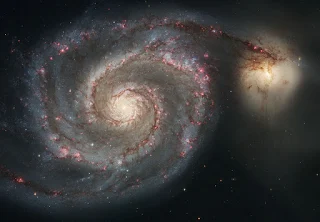The Whirlpool Galaxy, also known as Messier 51a, M51a, and NGC 5194, is an interacting grand-design spiral galaxy with a Seyfert 2 active galactic nucleus. It lies in the constellation Canes Venatici. It was the first galaxy to get classified as a spiral galaxy.
Some Facts about The Whirlpool Galaxy
Let us know some cool facts about this:
- The Whirlpool Galaxy was first discovered in 1773 by Charles Messier, who was charting the skies looking for objects that might be confused as comets.
- In 1845, astronomer William Parsons observed the galaxy pair with his telescope at Birr Castle, Ireland. He found the spiral structure of the Whirlpool.
- The Whirlpool and its companion, M51b have already passed by or through each other once as they dance through a cosmic merger. The smaller galaxy has been severely disrupted by the encounter, and the Whirlpool’s spiral arms are distorted.
- The Whirlpool Galaxy is undergoing huge bursts of star birth due to its ongoing encounter with its smaller companion galaxy.
- The whirlpool galaxy like many other galaxies has a supermassive black hole at its heart. It is surrounded by rings of dust. The core of the galaxy is quite active — making the Whirlpool what astronomers call a “Seyfert galaxy”.
- The Whirlpool’s companion, called M51b, is a dwarf galaxy. Because it is being torn apart by the ongoing interaction, it cannot be easily classified. Its current appearance makes it look like an irregular galaxy.
- A bridge of gas and dust ties the two galaxies together as they merge.
Few Deeply Scientific Words
The Whirlpool galaxies are 23 million light-years away (7 million parsecs). A neutron star (the dimmest type of star) has an absolute magnitude of 22. Let’s say this is a particularly dim one, at a magnitude of 23. Our neutron stars are 10^6.8 times further, so 34.2 magnitudes dimmer, at 57.2. Hubble can viably see up to magnitude 31. This is 26 magnitudes fainter. To see something 10 magnitudes dimmer, you multiply the aperture by 100. 100^2.6 is 160,000, multiplied by 2.5, Hubble’s aperture gives 400 kilometers. That’s one big telescope.
The End Notes
So. That's all in this article. I am trying hard to provide you interesting articles daily. So, you must have to appreciate me by commenting on your suggestions below. If you find this article useful, do share. Keep visiting The Notes and keep learning new things daily. Have a good one.
Cheers!



0 Comments
Please share your views.